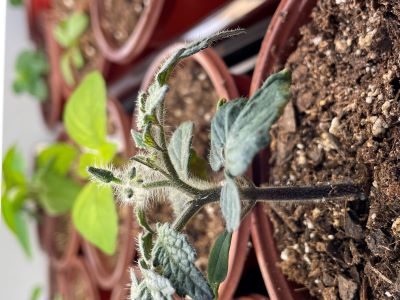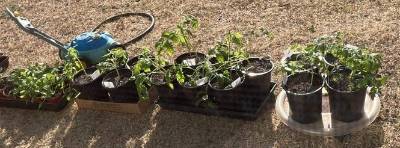Transitioning Seedlings Outside

It's almost time to start transitioning any vegetable starts or even plants purchased at the greenhouse outside. We still have a couple of weeks before it's safe to consider planting warm-season plants outside, but that doesn't mean we get to sit back and twiddle our thumbs till then. Let's discuss how to "harden off" your plants and troubleshoot common issues.
One of the biggest mistakes I see people make when starting their vegetables or purchasing plants from a greenhouse is not to harden them off before planting them outside. "Hardening off" is transitioning plants grown in a greenhouse or a protected indoor location to harsher outdoor conditions with fluctuating temperatures, wind, and sunlight. This should be a gradual process that slows the growth of the top of the plant, encourages more root development, reduces the amount of water in the plant, and thickens the cell wall. The process does "toughen up" the plant, changing from soft and supple to leaves and stems that are harder and firm to the touch. You should start this process several weeks before you want to plant outdoors. Rushing this step can lead to sunburn, stunted plants, wilting, and possibly even the plant dying from shock.
The first step of hardening a plant off should happen inside. The first step is to reduce the amount of water you give the plants gradually. You never allow them to wilt, but it will let the soil dry out, so the plants partially slow their growth. At this point, I would also add a fan blowing on the seedlings at a low speed to start acclimating them to the ever-present wind in Kansas. On days above 55 degrees outside, move the plants outside and place them in a shady, protected location for a few hours. Over the next couple of weeks, gradually extend the time outside and increase the amount of sun and wind the plants receive. Be sure to take them inside at night, especially if temperatures get into the 40s. After two weeks, the plants should be able to handle full sun and most of our winds. Remember, it's not just our seedlings that need this process; any plant grown in a garden center will also need to be transitioned outside, especially early in the season.

A couple of troubleshooting steps: if your plants have gotten leggy, you may need to transplant them into large containers before attempting to transition them outside. Leggy plants tend to struggle in the wind, and we have at least a couple of weeks before they can be safely planted outside. There is absolutely nothing wrong with bumping your plants into a larger container. Remember that leggy tomatoes can be planted deeper than the current soil line as they will root up the stem. Another common issue is yellowing leaves if you haven't been fertilizing your transplants. Unfortunately, we shouldn't be fertilizing as much during the hardening-off process because we want to slow the plant's growth, not increase it. I would continue to add some fertilizer, but nutrient deficiencies will have to wait to be corrected till the plants are planted in the ground.
The overall goal of hardening our plants off is to slow the growth of the plants and allow them to adjust to the fluctuations of the outside world. After a hardening-off period, our vegetables, even the ones that love heat, can tolerate a dip in night temperatures (not to freezing, but a more incredible night) without being harmed. The hardening-off process described above can also move your houseplants outside. Not all plants can handle full sun outside, but remember to gradually transition the plants to avoid burning the leaves.

Have questions? Contact our office where our Horticulture Extension Agent will assist you with questions.
Phone: (316) 321-9660
Email: callae@ksu.edu